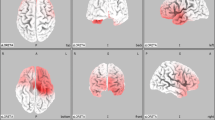Abstract
Purpose
We aimed to assess the relationship between electroencephalography (EEG) markers and seizure recurrence in cases with benign epilepsy with centrotemporal spikes (BECT) in a long-term follow-up study.
Methods
We analyzed the data of 52 children with BECT who were divided into 2 groups: the isolated group and recurrence group. The clinical profiles and initial/serial visual EEG recordings of both groups were evaluated. The entire follow-up period ranged from 12 to 65 months.
Results
None of the clinical characteristics differed between the 2 groups. Serial EEGs showed that the appearance of Rolandic spikes in the frontal region was more prevalent in the recurrence group. Moreover, a significant correlation was found between bilateral asynchronous discharges and seizure recurrence. However, on initial EEG of these patients, neither of the EEG features exhibited statistical significance.
Conclusion
The presence of frontal focus and bilateral asynchrony appeared to be hallmarks of BECT patients with higher risk for seizure recurrence.

Similar content being viewed by others
Abbreviations
- EEG:
-
electroencephalography
- BECT:
-
Benign epilepsy with centrotemporal spikes
- MRI:
-
Magnetic resonance imaging
- AEDs:
-
Antiepileptic drugs
- LEV:
-
Levetiracetam
- OXC:
-
Oxcarbazepine
- VPA:
-
Valproate
- CZP:
-
Clonazepam
- OR:
-
Odds ratio
- CI:
-
Confidence interval
- NS:
-
Not significant
References
Arhan E, Serdaroglu A, Ozturk Z, Aydin K, Hirfanoglu T (2018) Serial changes in the paroxysmal discharges in rolandic epilepsy may predict seizure recurrence: a retrospective 3-year follow-up study. Epilepsy Behav 82:150–154. https://doi.org/10.1016/j.yebeh.2018.03.014
Bouma PA, Bovenkerk AC, Westendorp RG, Brouwer OF (1997) The course of benign partial epilepsy of childhood with centrotemporal spikes: a meta-analysis. Neurology 48:430–437
Callenbach PM, Bouma PA, Geerts AT, Arts WF, Stroink H, Peeters EA, van Donselaar CA, Peters AC, Brouwer OF (2010) Long term outcome of benign childhood epilepsy with centrotemporal spikes: Dutch study of epilepsy in childhood. Seizure 19:501–506. https://doi.org/10.1016/j.seizure.2010.07.007
Cibula JE, Gilmore RL (1997) Secondary epileptogenesis in humans. J Clin Neurophysiol 14:111–127
Datta A, Sinclair DB (2007) Benign epilepsy of childhood with rolandic spikes: typical and atypical variants. Pediatr Neurol 36:141–145. https://doi.org/10.1016/j.pediatrneurol.2006.12.003
de Saint-Martin A, Petiau C, Massa R, Maquet P, Marescaux C, Hirsch E, Metz-Lutz MN (1999) Idiopathic rolandic epilepsy with "interictal" facial myoclonia and oromotor deficit: a longitudinal EEG and PET study. Epilepsia 40:614–620
Fejerman N, Caraballo R, Tenembaum SN (2000) Atypical evolutions of benign partial epilepsy of infancy with centro-temporal spikes. Rev Neurol 31:389–396
Kanemura H, Sano F, Aoyagi K, Sugita K, Aihara M (2012) Do sequential EEG changes predict atypical clinical features in rolandic epilepsy? Dev Med Child Neurol 54:912–917. https://doi.org/10.1111/j.1469-8749.2012.04358.x
Kanemura H, Sano F, Ohyama T, Sugita K, Aihara M (2014) Sequential EEG characteristics may predict seizure recurrence in rolandic epilepsy. Seizure 23:646–650. https://doi.org/10.1016/j.seizure.2014.05.006
Kellaway P (2000) The electroencephalographic features of benign centrotemporal (rolandic) epilepsy of childhood. Epilepsia 41:1053–1056
Loiseau P, Duche B, Cordova S, Dartigues JF, Cohadon S (1988) Prognosis of benign childhood epilepsy with centrotemporal spikes: a follow-up study of 168 patients. Epilepsia 29:229–235
Massa R, de Saint-Martin A, Carcangiu R, Rudolf G, Seegmuller C, Kleitz C, Metz-Lutz MN, Hirsch E, Marescaux C (2001) EEG criteria predictive of complicated evolution in idiopathic rolandic epilepsy. Neurology 57:1071–1079
Ong HT, Wyllie E (2000) Benign childhood epilepsy with centrotemporal spikes: is it always benign? Neurology 54:1182–1185
Riva D, Vago C, Franceschetti S, Pantaleoni C, D'Arrigo S, Granata T, Bulgheroni S (2007) Intellectual and language findings and their relationship to EEG characteristics in benign childhood epilepsy with centrotemporal spikes. Epilepsy Behav 10:278–285. https://doi.org/10.1016/j.yebeh.2006.12.003
Sarco DP, Boyer K, Lundy-Krigbaum SM, Takeoka M, Jensen F, Gregas M, Waber DP (2011) Benign rolandic epileptiform discharges are associated with mood and behavior problems. Epilepsy Behav 22:298–303. https://doi.org/10.1016/j.yebeh.2011.06.023
Staden U, Isaacs E, Boyd SG, Brandl U, Neville BG (1998) Language dysfunction in children with Rolandic epilepsy. Neuropediatrics 29:242–248. https://doi.org/10.1055/s-2007-973569
Vannest J, Tenney JR, Gelineau-Morel R, Maloney T, Glauser TA (2015) Cognitive and behavioral outcomes in benign childhood epilepsy with centrotemporal spikes. Epilepsy Behav 45:85–91. https://doi.org/10.1016/j.yebeh.2015.01.041
Watemberg N, Afunevitz S, Ganelin-Cohen E, Mahajnah M (2018) Clinical features at the time of diagnosis of benign epilepsy with centrotemporal spikes do not predict subsequent seizures. Pediatr Neurol 88:36–39. https://doi.org/10.1016/j.pediatrneurol.2018.08.024
Weglage J, Demsky A, Pietsch M, Kurlemann G (1997) Neuropsychological, intellectual, and behavioral findings in patients with centrotemporal spikes with and without seizures. Dev Med Child Neurol 39:646–651
Wirrell EC (1998) Benign epilepsy of childhood with centrotemporal spike. Epilepsia 39:32–41
Funding
This work was supported by Wuxi Young Medical Talents (Grant Number QNRC021); Medical Innovation Team of Jiangsu Province (Grant Number CXTDB2017016); and Wuxi Medical Development Discipline (Grant Number FZXK001).
Author information
Authors and Affiliations
Corresponding author
Ethics declarations
Conflict of interest
The authors declare that there is no conflict of interest.
Additional information
Publisher’s note
Springer Nature remains neutral with regard to jurisdictional claims in published maps and institutional affiliations.
Rights and permissions
About this article
Cite this article
Tang, H., Wang, Y., Hua, Y. et al. Analysis of serial electroencephalographic predictors of seizure recurrence in Rolandic epilepsy. Childs Nerv Syst 35, 1579–1583 (2019). https://doi.org/10.1007/s00381-019-04275-0
Received:
Accepted:
Published:
Issue Date:
DOI: https://doi.org/10.1007/s00381-019-04275-0




